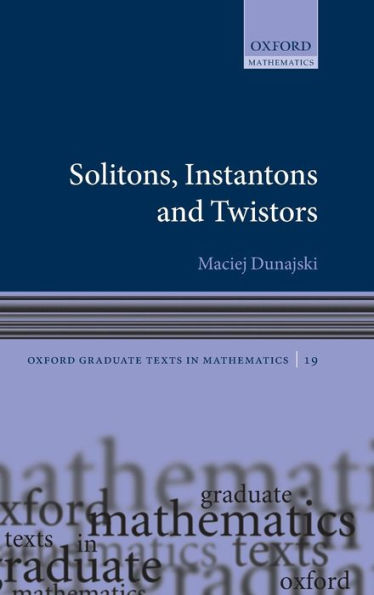Solitons, Instantons, and Twistors available in Hardcover

- ISBN-10:
- 0198570627
- ISBN-13:
- 9780198570622
- Pub. Date:
- 02/08/2010
- Publisher:
- Oxford University Press
- ISBN-10:
- 0198570627
- ISBN-13:
- 9780198570622
- Pub. Date:
- 02/08/2010
- Publisher:
- Oxford University Press

Hardcover
Buy New
$165.00Overview
The book provides a self-contained and accessible introduction to the subject. It starts with an introduction to integrability of ordinary and partial differential equations. Subsequent chapters explore symmetry analysis, gauge theory, vortices, gravitational instantons, twistor transforms, and anti-self-duality equations. The three appendices cover basic differential geometry, complex manifold theory, and the exterior differential system.

Product Details
| ISBN-13: | 9780198570622 |
|---|---|
| Publisher: | Oxford University Press |
| Publication date: | 02/08/2010 |
| Series: | Oxford Graduate Texts in Mathematics , #19 |
| Pages: | 374 |
| Product dimensions: | 6.00(w) x 9.30(h) x 1.00(d) |
About the Author
Maciej Dunajski is a Fellow of Clare College, and a Professor of Mathematical Physics at the Department of Applied Mathematics and Theoretical Physics, at the University of Cambridge. His research interests are in differential and projective Geometry, Solitons, and General Theory of Relativity. In 2021 he was awarded the Atiyah Fellowship by the London Mathematical Society. Dunajski is the winner of the 2023 Gravity Research Foundation Award, and the author of Geometry: A Very Short Introduction (OUP 2022).
Table of Contents
List of Figures xii
List of Abbreviations xiii
1 Integrability in classical mechanics 1
1.1 Hamiltonian formalism 1
1.2 Integrability and action-angle variables 4
1.3 Poisson structures 14
2 Soliton equations and the inverse scattering transform 20
2.1 The history of two examples 20
2.1.1 A physical derivation of KdV 21
2.1.2 Bäcklund transformations for the Sine-Gordon equation 24
2.2 Inverse scattering transform for KdV 25
2.2.1 Direct scattering 28
2.2.2 Properties of the scattering data 29
2.2.3 Inverse scattering 30
2.2.4 Lax formulation 31
2.2.5 Evolution of the scattering data 32
2.3 Reflectionless potentials and solitons 33
2.3.1 One-soliton solution 34
2.3.2 N-soliton solution 35
2.3.3 Two-soliton asymptotics 36
3 Hamiltonian formalism and zero-curvature representation 43
3.1 First integrals 43
3.2 Hamiltonian formalism 46
3.2.1 Bi-Hamiltonian systems 46
3.3 Zero-curvature representation 48
3.3.1 Riemann-Hilbert problem 50
3.3.2 Dressing method 52
3.3.3 From Lax representation to zero curvature 54
3.4 Hierarchies and finite-gap solutions 56
4 Lie symmetries and reductions 64
4.1 Lie groups and Lie algebras 64
4.2 Vector fields and one-parameter groups of transformations 67
4.3 Symmetries of differential equations 71
4.3.1 How to find symmetries 74
4.3.2 Prolongation formulae 75
4.4 Painlevé equations 78
4.4.1 Painlevé test 82
5 Lagrangian formalism and field theory 85
5.1 A variational principle 85
5.1.1 Legendre transform 87
5.1.2 Symplectic structures 88
5.1.3 Solution space 89
5.2 Field theory 90
5.2.1 Solution space and the geodesic approximation 92
5.3 Scalar kinks 93
5.3.1 Topology and Bogomolny equations 96
5.3.2 Higher dimensions and a scaling argument 98
5.3.3 Homotopy in field theory 99
5.4 Sigma model lumps 100
6 Gauge field theory 105
6.1 Gauge potential and Higgs field 106
6.1.1 Scaling argument 108
6.1.2 Principal bundles 109
6.2 Dirac monopole and flux quantization 110
6.2.1 Hopf fibration 112
6.3 Non-abelian monopoles 114
6.3.1 Topology of monopoles 115
6.3.2 Bogomolny-Prasad-Sommerfeld (BPS) limit 116
6.4 Yang-Mills equations and instantons 119
6.4.1 Chern and Chern-Simons forms 120
6.4.2 Minimal action solutions and the anti-self-duality condition 122
6.4.3 Ansatz for ASD fields 123
6.4.4 Gradient flow and classical mechanics 124
7 Integrability of ASDYM and twistor theory 129
7.1 Lax pair 129
7.1.1 Geometric interpretation 132
7.2 Twistor correspondence 133
7.2.1 History and motivation 133
7.2.2 Spinor notation 137
7.2.3 Twistor space 139
7.2.4 Penrose-Ward correspondence 141
8 Symmetry reductions and the integrable chiral model 149
8.1 Reductions to integrable equations 149
8.2 Integrable chiral model 154
8.2.1 Soliton solutions 157
8.2.2 Lagrangian formulation 165
8.2.3 Energy quantization of time-dependent unitons 168
8.2.4 Moduli space dynamics 173
8.2.5 Mini-twistors 181
9 Gravitational instantons 191
9.1 Examples of gravitational instantons 191
9.2 Anti-self-duality in Riemannian geometry 195
9.2.1 Two-component spinors in Riemannian signature 198
9.3 Hyper-Kähler metrics 202
9.4 Multi-centred gravitational instantons 206
9.4.1 Belinskii-Gibbons-Page-Pope class 210
9.5 Other gravitational instantons 212
9.5.1 Compact gravitational instantons and K3 215
9.6 Einstein-Maxwell gravitational instantons 216
9.7 Kaluza-Klein monopoles 221
9.7.1 Kaluza-Klein solitons from Einstein-Maxwell instantons 222
9.7.2 Solitons in higher dimensions 226
10 Anti-self-dual conformal structures 229
10.1 α-surfaces and anti-self-duality 230
10.2 Curvature restrictions and their Lax pairs 231
10.2.1 Hyper-Hermitian structures 232
10.2.2 ASD Kähler structures 234
10.2.3 Null-Kähler structures 236
10.2.4 ASD Einstein structures 237
10.2.5 Hyper-Kähler structures and heavenly equations 238
10.3 Symmetries 246
10.3.1 Einstein-Weyl geometry 246
10.3.2 Null symmetries and projective structures 253
10.3.3 Dispersionless integrable systems 256
10.4 ASD conformal structures in neutral signature 262
10.4.1 Conformal compactification 263
10.4.2 Curved examples 263
10.5 Twistor theory 265
10.5.1 Curvature restrictions 270
10.5.2 ASD Ricci-flat metrics 272
10.5.3 Twistor theory and symmetries 283
Appendix A Manifolds and topology 287
A.1 Lie groups 290
A.2 Degree of a map and homotopy 294
A.2.1 Homotopy 296
A.2.2 Hermitian projectors 298
Appendix B Complex analysis 300
B.1 Complex manifolds 301
B.2 Holomorphic vector bundles and their sections 303
B.3 Cech cohomology 307
B.3.1 Deformation theory 308
Appendix C Overdetermined PDEs 310
C.1 Introduction 310
C.2 Exterior differential system and Frobenius theorem 314
C.3 Involutivity 320
C.4 Prolongation 324
C.4.1 Differential invariants 326
C.5 Method of characteristics 332
C.6 Cartan-Kähler theorem 335
References 344
Index 355
